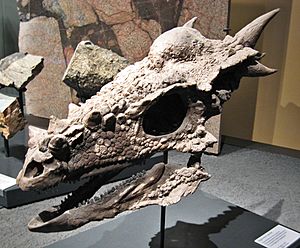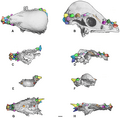Stygimoloch facts for kids
Quick facts for kids Stygimoloch |
|
|---|---|
 |
|
| Reconstructed skull at the Museum für Naturkunde, Berlin | |
| Scientific classification | |
| Genus: |
Stygimoloch
|
| Species: |
spinifer
|
| Synonyms | |
Stygimoloch (pronounced STIH-jee-MO-lock) was a fascinating plant-eating dinosaur. It lived during the late Cretaceous period, about 68 to 65 million years ago. This dinosaur is famous for its unique skull, which had bony spikes and knobs.
Stygimoloch was a bipedal dinosaur, meaning it walked on two legs. It belonged to a group called ornithischian dinosaurs, known for their bird-like hips. These dinosaurs, especially the pachycephalosaurs, had thick, domed, and often spiky skulls. Scientists believe they might have used their strong heads for defense or in friendly contests with other dinosaurs of their kind.
Contents
Meet Stygimoloch: The Spiky-Headed Dinosaur
Stygimoloch is a very interesting dinosaur because of its head. Its name means "Styx demon," referring to the river Styx from Greek mythology and its fierce, spiky look. This dinosaur was part of a family called Pachycephalosauridae.
What Did Stygimoloch Look Like?
The most striking feature of Stygimoloch was its skull. It had a tall, narrow dome on top, but it wasn't as thick as some of its relatives. What made it stand out were the long, sharp spikes pointing backward from the back of its head. It also had smaller bony knobs and spikes around its snout and face.
Stygimoloch was a medium-sized dinosaur. It probably grew to about 10 feet (3 meters) long, which is roughly the length of a small car. It walked on two strong legs, and its front limbs were much shorter. Its body was likely covered in scales, similar to modern reptiles.
Where Did Stygimoloch Live?
Stygimoloch lived in North America during the very end of the Cretaceous period. This was a time when many different dinosaurs roamed the Earth. Its fossils have been found in places like Montana and Wyoming in the United States.
The environment where Stygimoloch lived was warm and humid. There were vast forests, rivers, and floodplains. It shared its home with other famous dinosaurs. These included the mighty Tyrannosaurus rex and the horned Triceratops.
What Did Stygimoloch Eat?
Stygimoloch was a herbivore, meaning it ate plants. Its teeth were small and leaf-shaped, perfect for chewing tough plant material. It likely fed on low-growing plants, ferns, and shrubs. Its strong jaws would have helped it grind up its food.
Scientists study the teeth and jaw structure of dinosaurs to figure out what they ate. The design of Stygimoloch's mouth shows it was well-suited for a plant-based diet. It probably spent its days browsing through the Cretaceous forests.
The Pachycephalosaur Family
Stygimoloch belongs to the Pachycephalosauridae family. This group of dinosaurs is famous for their incredibly thick skulls. The most well-known member is Pachycephalosaurus, which had an even larger, more solid dome.
Head-Butting Behavior
One of the most debated topics about pachycephalosaurs is how they used their thick skulls. Many scientists believe they engaged in head-butting. This behavior might have been used for defense against predators. It could also have been for showing dominance within their own species.
Imagine two male Stygimoloch dinosaurs butting heads to decide who gets to lead the group. Their strong skulls would have protected their brains during these impacts. However, some scientists think the domes were more for display. They might have been brightly colored to attract mates or scare off rivals.
How We Learn About Them
We learn about Stygimoloch and other dinosaurs from their fossils. Paleontologists, who are scientists who study fossils, dig up bones and other remains. These fossils give us clues about what dinosaurs looked like, what they ate, and how they lived.
For Stygimoloch, most of what we know comes from skull fragments and teeth. Complete skeletons are very rare. Each new fossil discovery helps us piece together the puzzle of these ancient creatures. It helps us understand life on Earth millions of years ago.
Images for kids
-
Casts of three skulls, representing possible growth stages, Museum of the Rockies










